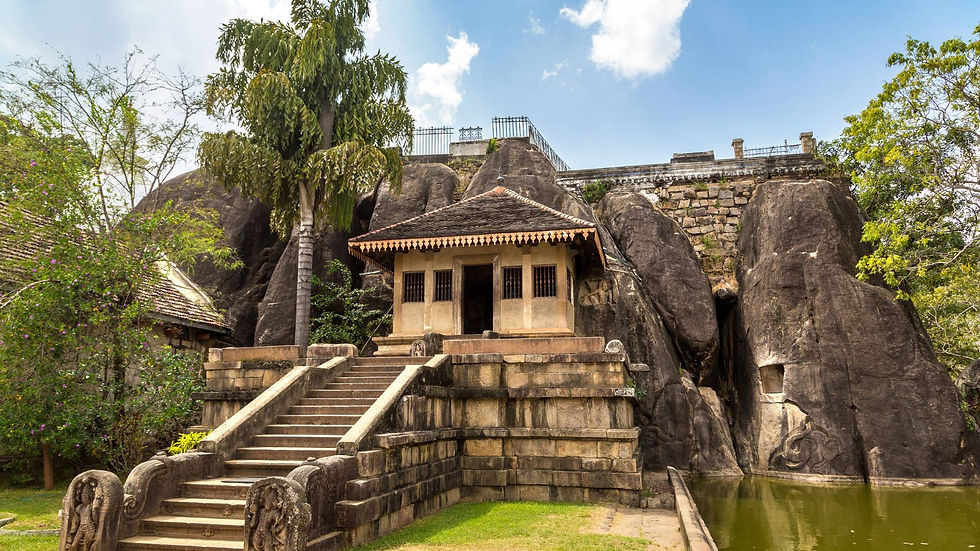Best Time to Visit Sri Lanka: Weather & Climate - Tips for Your Trip
- Anna & Tom
- Oct 2, 2024
- 4 min read
Updated: Nov 27, 2024
Sri Lanka, an island nation in the Indian Ocean, is a fascinating destination year-round. However, there are specific times that are particularly recommended, depending on the activities and experiences you plan during your trip.
In this article, we will look at the best time to visit Sri Lanka, based on the seasons, regions, and climate of the island. Additionally, you will find exciting activities that are especially worthwhile in certain months.
If you’re looking for inspiration for your itinerary, you’ll find it in this post.

Table of Contents
1. Information on Climate and Weather in Sri Lanka
Before diving into the details of the best travel times, it’s essential to understand Sri Lanka’s climate. The country has a tropical climate, influenced by two monsoons. Therefore, the best time to visit depends heavily on the different monsoon seasons.
Southwest Monsoon (Yala): This monsoon brings rain to the southwest of the island from May to September. Places like Colombo, Galle, and the southern part of Sri Lanka experience their rainy season during this period.
Northeast Monsoon (Maha): The northeast monsoon brings rain to northeastern Sri Lanka, including areas like Trincomalee and Jaffna, from December to March.
2. The Optimal Travel Time by Season for Sri Lanka
When planning your trip to Sri Lanka, you should consider whether you prefer to visit during the high season, with its increased tourism and higher prices, or whether the off-season might be more suitable for you.
Below, we’ve outlined the different seasons in Sri Lanka with some helpful information.
High Season (December to March)
The high season in Sri Lanka coincides with the northeast monsoon, making this an excellent time to explore the east and north of the island. The temperatures are pleasantly warm, and the chances of rain are low. This is ideal if you plan to visit the beaches of Trincomalee or explore the cultural gems of Anuradhapura and Polonnaruwa.

Shoulder Season (April to September)
During this time, the southwest monsoon prevails, bringing rain to the southwest and parts of the central highlands. Although this is considered the rainy season, the rainfall is usually not continuous and often occurs in short bursts. This period is ideal for visiting the cultural triangle or traveling to the tea plantations in Nuwara Eliya.

Off-Season (Rainy Season from October to November)
This is the transition period between the monsoons. While there may be more rain, prices are generally lower, and there are fewer tourist crowds. If you’re flexible and can adjust your plans according to the weather, you can still enjoy some lovely days on the island during the off-season.
3. Best Time to Visit Sri Lanka by Region
Depending on where you plan to travel in Sri Lanka, it’s worth checking when the best travel time is for each location. If you’re planning a round trip through Sri Lanka, it’s advisable to choose a month with pleasant weather across the island. If you’re focusing on the south coast or the south and west coasts, travel during the ideal season for those regions.
West Coast (Colombo, Negombo)
Best Travel Time: December to March (high season)
Why: Dry and sunny weather, perfect for beach stays and watersports
Southwest Coast (Galle, South around Mirissa)
Best Travel Time: December to March (high season)
Why: Little rain and calm seas, ideal for whale watching and beach relaxation
East Coast (Trincomalee, Arugam Bay)
Best Travel Time: April to September (shoulder season)
Why: Dry weather on the east coast during the southwest monsoon in the west, perfect for beach visits and diving
Central Highlands (Kandy, Nuwara Eliya)
Best Travel Time: December to March (high season)
Why: Pleasant temperatures and little rain, ideal for tea plantation visits and hiking
Northern Regions (Jaffna)
Best Travel Time: May to September (southwest monsoon)
Why: Dry and warm weather, a great time to explore the cultural heritage of the northern regions
Cultural Triangle (Anuradhapura, Polonnaruwa)
Best Travel Time: April to September (shoulder season)
Why: Fewer tourists and pleasant temperatures for sightseeing and exploring ancient sites

4. Tips and Activities in Sri Lanka
For Beach Lovers: Visit the east coast during the high season (December to March) for clear waters and perfect beach weather
For Culture Enthusiasts: The shoulder season (April to September) is ideal for sightseeing in the cultural triangle, as there are significantly fewer crowds during this time
For Nature Lovers: The off-season (October to November) is a great time to experience Sri Lanka’s lush landscapes without being surrounded by too many tourists. Additionally, you might find great hotel deals during this period
5. Conclusion: The Best Time to Visit Sri Lanka
The best time to visit Sri Lanka depends on your preferences and travel destinations. If you’re flexible and want to explore various regions of the island, the shoulder season could be perfect for you. However, if you’re looking for ideal temperatures, the high season is the better choice.
We visited Sri Lanka in August and focused on the southwest. During our trip, we visited tea plantations and national parks and had an overall fantastic time in this beautiful country.
We hope these insights help with your trip planning, and we wish you an amazing time in Sri Lanka!
Want more insights into our travels? Check out our Instagram channels tom_rbg_ and anna_rbg_! If you have any questions about the routes, feel free to contact us through these channels!













